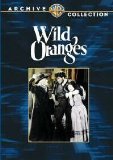| Reviews & Columns |
|
Reviews DVD TV on DVD Blu-ray 4K UHD International DVDs In Theaters Reviews by Studio Video Games Features Collector Series DVDs Easter Egg Database Interviews DVD Talk Radio Feature Articles Columns Anime Talk DVD Savant Horror DVDs The M.O.D. Squad Art House HD Talk Silent DVD
|
DVD Talk Forum |
|
|
| Resources |
|
DVD Price Search Customer Service #'s RCE Info Links |
|
Columns
|
|
|
Wild Oranges
THE MOVIE:
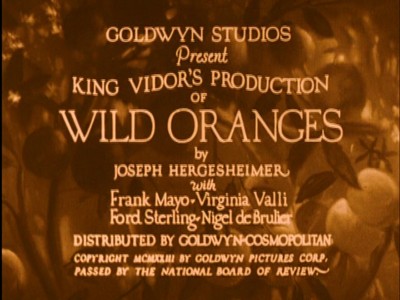
It's kind of crazy to think that King Vidor was already a movie industry veteran when he made Wild Oranges in 1924, but he already had thirty directorial credits to his name and had been at it for more than ten years. Godard once famously declared that Nicholas Ray was cinema, and if that's the case, is it possible King Vidor was cinema's grandpappy?
It's a facetious remark, but there might be something to it. Both Ray and Vidor had an attraction to amped-up melodrama and they weren't afraid to let their cameras get carried away by the emotion. They also both liked strange characters that lost the lines between personal integrity, eccentricity, and full-on madness. Vidor's most famous silent films, including The Big Parade and The Crowd, were still ahead of him, but this developmental full-length shows a cinematic storyteller well on his way to where he was going.
Vidor adapted Wild Oranges from a novel by Joseph Hergesheimer. The movie opens with a tragic event: a young married couple is out for a buggy ride, and when the husband loses control of his horses, the wife is thrown from the carriage and killed. In his despair, the widower, John Woolfolk (Frank Mayo), rejects life and takes to sailing the lonesome seas with his right-hand man (Ford Sterling). Stopping at an isolated southern inlet, they come across a mentally unstable Civil War vet (Nigel de Brulier) and his granddaughter Millie (Virginia Valli). Grandpa has a bit of PTSD, and he is scared to leave his swampy land. Like John, he's rejected outside life. This decision has also condemned Millie to a virtual imprisonment. Their only company in this private wilderness is a demented manchild named Iscah (Charles A. Post). This giant is cruel, stupid, and naturally, sexually attracted to Millie, but without any real knowledge of how to act on his lust. His idea of courtship is threatening to let crocodiles eat her unless she gives him a kiss.
The arrival of John upsets the precarious order of things. Millie sees a romantic figure whose boat is a means to escape, the old man sees the horrors of the outside world he's been trying to avoid, and Iscah sees a rival. Even John's shipmate is threatened by the quick attraction between John and Millie. There is an underlying homoerotic tension between him and his captain. They've been alone on their boat for years, living, as Millie puts it, like a couple of old women.
Vidor creates a psychosexual landscape in Wild Oranges, bending this fairly conventional dramatic plot into something that appears normal on the surface but is totally warped underneath. Each character represents some kind of primal urge, be it fear or loneliness or love, and they are as much metaphor as they are human, if not more so. (The acting is appropriately overwrought and often one-note, just as the script requires.) Even the landscape is in on the game. Iscah is a creature of the swamp, both dangerous and thick. Millie grows the wild oranges of the title, which John first tastes and rejects as bitter, before realizing he wants to taste them again. Likewise, he first rejects Millie, choosing his exile over romance, but he's ultimately unable to get her out of his mind. In one of the more inventive sequences, she comes to him as an apparition of his psyche, tempting him with the fruits of her Eden. He tries to ward her off with his bad memories, and Vidor even cuts back to his wife's death scene we saw at the start of the movie, but it's too late, John's addicted.
Some of the tropes in Wild Oranges come out of a southern gothic tradition. The creepy old man staring out of the window of his rundown home, the oaf whose menace is so apparent even dogs bark at him, the raccoons and the spiders and the bats as symbols of nature grown out of control--these are like something out of an old horror tale. When John returns for Millie, it's during a windswept storm, the very weather whipped into a fury by these passions. To be honest, there is more to look at in Wild Oranges than there is story. The narrative is thin, but Vidor packs so much detail into each frame, the mis en scene carries it.
The climactic scenes get pretty crazy. Iscah ties Millie to the bed and gags her, lasciviously stroking her cheek as she squirms at his touch. When John comes to rescue her, he and the ogre get into a knock-down, drag-out fist fight. They beat the holy hell out of each other in a high-speed frenzy, with Vidor regularly moving in from a two-shot to tight close-ups to show the damage they are doing to one another. There is one brilliant special effect where a charging dog is represented by two pin-point lights in the dark. No body, no snarls or teeth, just two eyes in the night, like the headlights of a speeding truck. It's the kind of finale that just keeps going. The action grows more intense, the elements flare and rage, and the villain suffers a gruesome death as the good guys sail away toward love and freedom.
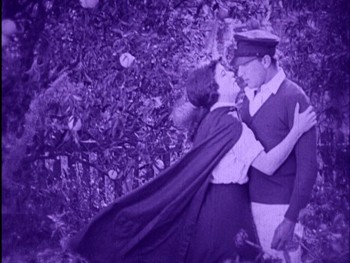
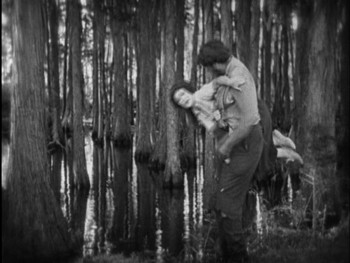
THE DVD
Video/Packaging:
Wild Oranges has been released under the banner of the Warner Bros. Archive Collection, a direct-to-order line set up by the studio to release some of their back catalogue in a no-frills package to collectors. Under the program, film fans pay a premium full-retail price to get a movie they can't otherwise get; the downside is that there is some skimping to keep costs down, which may strike some as backwards since the consumer price is up. This skimping includes recording the movie on a blue-backed DVD and printing the cover on cheap stock and what looks like a standard color printer no different than most of us have at home. There is also an on-demand download option from most of the films, offering them for a slightly less fee. The set-up on all the discs is a functional "play the movie " menu and that's it.
This silent film was previously restored for Turner Classic Movies. The tinted full-frame picture shows a lot of wear. There are scratches up and down the film throughout, but the images are generally quite clear behind it. Sometimes the frame is sharper in the middle, with the outer edges having faded over time, but even then, not so much to obscure what we are meant to see. There are also some jumpy edits and/or missing frames from time to time. About what you might expect from a film this old. In terms of digital presentation, there is some interlacing, but it's not too bad.
Sound:
Wild Oranges sports a new score by composer Vivek Maddala. It's mixed in basic stereo and sounds pretty good on a technical level. I at times found the music itself to be overwrought or even slightly disjointed from the story. It is somewhat conventional, not overly creative.
The title cards look good and can be clearly read. I am not positive if they are the original cards, but they look like it. If they have been recreated, the studio has integrated them into the movie very well.
Extras:
None.
FINAL THOUGHTS:
Recommended. The 1924 silent film Wild Oranges is a good early example of the kind of crazed melodrama that would eventually prove to be King Vidor's specialty. The story of an emotionally bruised man finding an isolated girl in a remote, dysfunctional outpost isn't necessarily big on surprises, but Vidor turns it into a lusty visual feast. Each frame pants with fevered detail, making for a fun ride. It's not one of Vidor's best, but I got a kick out of it.
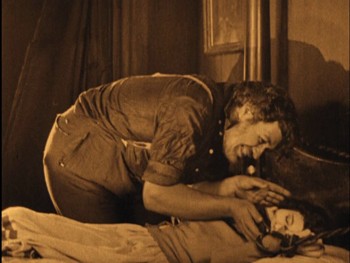
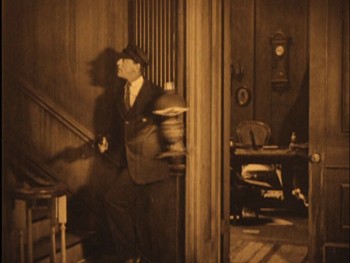
Jamie S. Rich is a novelist and comic book writer. He is best known for his collaborations with Joelle Jones, including the hardboiled crime comic book You Have Killed Me, the challenging romance 12 Reasons Why I Love Her, and the 2007 prose novel Have You Seen the Horizon Lately?, for which Jones did the cover. All three were published by Oni Press. His most recent projects include the futuristic romance A Boy and a Girl with Natalie Nourigat; Archer Coe and the Thousand Natural Shocks, a loopy crime tale drawn by Dan Christensen; and the horror miniseries Madame Frankenstein, a collaboration with Megan Levens. Follow Rich's blog at Confessions123.com.
|
| Popular Reviews |
| Sponsored Links |
|
|
| Sponsored Links |
|
|
| Release List | Reviews | Shop | Newsletter | Forum | DVD Giveaways | Blu-Ray | Advertise |
|
Copyright 2024 DVDTalk.com All Rights Reserved. Legal Info, Privacy Policy, Terms of Use,
Manage Preferences,
Your Privacy Choices | |||||||









